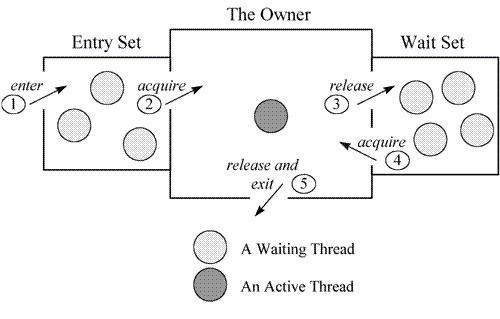synchronized有以下三种使用方式:
- 同步普通方法,锁的是当前对象。
- 同步静态方法,锁的是当前 Class 对象。
- 同步块,锁的是()中的对象。
1. 实现原理:
JVM 是通过进入、退出对象监视器( Monitor )来实现对方法、同步块的同步的。
具体实现是在编译之后在同步方法调用前加入一个 monitor.enter 指令,在退出方法和异常处插入 monitor.exit 的指令。
其本质就是对一个对象监视器( Monitor )进行获取,而这个获取过程具有排他性从而达到了同一时刻只能一个线程访问的目的。
而对于没有获取到锁的线程将会阻塞到方法入口处,直到获取锁的线程 monitor.exit 之后才能尝试继续获取锁。

看一段代码
public class SynchronizedDemo {
public void method() {
synchronized (this) {
System.out.println("synchronized");
}
}
}
执行javap -c SynchronizedDemo.class得到下面信息
Compiled from "SynchronizedDemo.java"
public class thread.start.SynchronizedDemo {
public thread.start.SynchronizedDemo();
Code:
0: aload_0
1: invokespecial #1 // Method java/lang/Object."<init>":()V
4: return
public void method();
Code:
0: aload_0
1: dup
2: astore_1
3: monitorenter
4: getstatic #2 // Field java/lang/System.out:Ljava/io/PrintStream;
7: ldc #3 // String Method 1 start
9: invokevirtual #4 // Method java/io/PrintStream.println:(Ljava/lang/String;)V
12: aload_1
13: monitorexit
14: goto 22
17: astore_2
18: aload_1
19: monitorexit
20: aload_2
21: athrow
22: return
Exception table:
from to target type
4 14 17 any
17 20 17 any
}
可以看到在同步块的入口和出口分别有monitorenter和monitorexit
对于下面的代码
public class SynchronizedDemo {
public synchronized void methodB() {
System.out.println("synchronized");
}
}
执行javap -c -v SynchronizedDemo.class得到下面信息
// 省略部分内容
{
public SynchronizedDemo();
descriptor: ()V
flags: ACC_PUBLIC
Code:
stack=1, locals=1, args_size=1
0: aload_0
1: invokespecial #1 // Method java/lang/Object."<init>":()V
4: return
LineNumberTable:
line 1: 0
LocalVariableTable:
Start Length Slot Name Signature
0 5 0 this LSynchronizedDemo;
public synchronized void methodB();
descriptor: ()V
flags: ACC_PUBLIC, ACC_SYNCHRONIZED
Code:
stack=2, locals=1, args_size=1
0: getstatic #2 // Field java/lang/System.out:Ljava/io/PrintStream;
3: ldc #3 // String synchronized
5: invokevirtual #4 // Method java/io/PrintStream.println:(Ljava/lang/String;)V
8: return
LineNumberTable:
line 4: 0
line 5: 8
LocalVariableTable:
Start Length Slot Name Signature
0 9 0 this LSynchronizedDemo;
}
发现没有monitorenter和monitorexit,因为这里monitorenter 和 monitorexit 操作所对应的锁对象是隐式的
被 synchronized 修饰的方法会有一个ACC_SYNCHRONIZED标志。当某个线程要访问某个方法的时候,会首先检查方法是否有ACC_SYNCHRONIZED标志,如果有则需要先获得 monitor 锁,然后才能开始执行方法,方法执行之后再释放 monitor 锁。
2. 重入机制
2.1. monitorenter
每个对象都有一个监视器锁(monitor),当monitor被占用时就会处于锁定状态。线程执行monitorenter指令时尝试获取monitor的所有权,过程如下:
- 如果monitor的进入数为0,则该线程进入monitor,然后将进入数设置为1,该线程即为monitor的所有者;
- 如果线程已经占有该monitor,只是重新进入,则进入monitor的进入数加1;
- 如果其他线程已经占用了monitor,则该线程进入阻塞状态,直到monitor的进入数为0,再重新尝试获取monitor的所有权;
monitorenter :Each object is associated with a monitor. A monitor is locked if and only if it has an owner. The thread that executes monitorenter attempts to gain ownership of the monitor associated with objectref, as follows:
• If the entry count of the monitor associated with objectref is zero, the thread enters the monitor and sets its entry count to one. The thread is then the owner of the monitor.
• If the thread already owns the monitor associated with objectref, it reenters the monitor, incrementing its entry count.
• If another thread already owns the monitor associated with objectref, the thread blocks until the monitor’s entry count is zero, then tries again to gain ownership.
2.2. monitorexit
执行monitorexit的线程必须是objectref所对应的monitor的所有者。指令执行时,monitor的进入数减1,如果减1后进入数为0,那线程退出monitor,不再是这个monitor的所有者。其他被这个monitor阻塞的线程可以尝试去获取这个 monitor 的所有权。
monitorexit:The thread that executes monitorexit must be the owner of the monitor associated with the instance referenced by objectref.
The thread decrements the entry count of the monitor associated with objectref. If as a result the value of the entry count is zero, the thread exits the monitor and is no longer its owner.
Other threads that are blocking to enter the monitor are allowed to attempt to do so.
synchronized 的语义底层是通过一个 Monitor 的对象来完成,任何对象都有一个monitor与之相关联,当且一个monitor被持有之后,他将处于锁定状态。线程执行到monitorenter指令时,将会尝试获取对象所对应的monitor所有权,即尝试获取对象的锁;
wait/notify等方法也依赖于monitor对象,这就是为什么只有在同步的块或者方法中才能调用wait/notify等方法,否则会抛出java.lang.IllegalMonitorStateException的异常的原因
3. Monitor
什么是Monitor?我们可以把它理解为一个同步工具,也可以描述为一种同步机制,它通常被描述为一个对象。 与一切皆对象一样,所有的Java对象是天生的Monitor,每一个Java对象都有成为Monitor的潜质,因为在Java的设计中 ,每一个Java对象都带了一把看不见的锁,它叫做内部锁或者Monitor锁。
Monitor 是线程私有的数据结构,每一个线程都有一个可用monitor record列表,同时还有一个全局的可用列表。每一个被锁住的对象都会和一个monitor关联(对象头的MarkWord中的LockWord指向monitor的起始地址),同时monitor中有一个Owner字段存放拥有该锁的线程的唯一标识,表示该锁被这个线程占用。其结构如下:

- Owner:初始时为NULL表示当前没有任何线程拥有该monitor record,当线程成功拥有该锁后保存线程唯一标识,当锁被释放时又设置为NULL;
- EntryQ: 关联一个系统互斥锁(semaphore),阻塞所有试图锁住monitor record失败的线程
- RcThis: 表示blocked或waiting在该monitor record上的所有线程的个数。
- Nest: 用来实现重入锁的计数。
- HashCode:保存从对象头拷贝过来的HashCode值(可能还包含GC age)。
- Candidate:用来避免不必要的阻塞或等待线程唤醒,因为每一次只有一个线程能够成功拥有锁,如果每次前一个释放锁的线程唤醒所有正在阻塞或等待的线程,会引起不必要的上下文切换(从阻塞到就绪然后因为竞争锁失败又被阻塞)从而导致性能严重下降。Candidate只有两种可能的值0表示没有需要唤醒的线程1表示要唤醒一个继任线程来竞争锁。
Monitor 的工作机理

- 线程进入同步方法中。
- 为了继续执行临界区代码,线程必须获取 Monitor 锁。如果获取锁成功,将成为该监视者对象的拥有者。任一时刻内,监视者对象只属于一个活动线程(The Owner)
- 拥有监视者对象的线程可以调用 wait() 进入等待集合(Wait Set),同时释放监视锁,进入等待状态。
- 其他线程调用 notify() / notifyAll() 接口唤醒等待集合中的线程,这些等待的线程需要重新获取监视锁后才能执行 wait() 之后的代码。
- 同步方法执行完毕了,线程退出临界区,并释放监视锁。
4. 锁存放的位置
锁标记存放在Java对象头的Mark Word中。
https://edgar615.github.io/java-object-memory.html
Mark Word在不同的锁状态下存储的内容不同,在32位JVM中是这么存的:

Mark Word:默认存储对象的HashCode,分代年龄和锁标志位信息。这些信息都是与对象自身定义无关的数据,所以Mark Word被设计成一个非固定的数据结构以便在极小的空间内存存储尽量多的数据。它会根据对象的状态复用自己的存储空间,也就是说在运行期间Mark Word里存储的数据会随着锁标志位的变化而变化。
5. 参考资料
https://www.jianshu.com/p/2ba154f275ea
https://www.jianshu.com/p/e62fa839aa41
https://mp.weixin.qq.com/s/tV48ZCwZUAUO-1xL7uESUA
